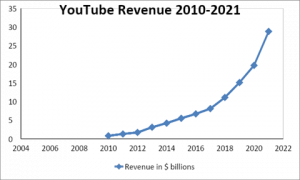Video has dominated the business marketing scene for a while now, and that dominance continued in 2021. In the wake of the pandemic, many enterprises shifted to a more remote workforce, increasing reliance on video as a marketing tool and for internal communication purposes.
Moreover, video consumption increased remarkably over the past year as consumers sought exciting ways to learn about their favorite brand’s offerings.
As 2023 progresses, there is an expectation that video continues to get better and that more enterprises will adopt video marketing.
Any enterprise putting off video use, for whatever reason, will be left behind in the marketing space, and those that prioritize video in its different forms will be at the top of the pyramid.

What makes us so sure that video will create the most value for businesses in 2023?
Well, as they say, numbers don’t lie, and the year on year statistics have demonstrated how vital videotubes are for businesses.
YouTube video statistics: 2010 – 2021

YouTube was launched in 2005 and has since grown to be the biggest online video repository worldwide.
The video platform features a variety of personal and corporate videos and, as of 2020, was the number one destination for streaming online content and the most organically visited website in the world.
YouTube User Growth

YouTube’s annual viewers increased from 800 million by the close of 2011 to 2.3 billion users by the close of 2020. Source: YouTube
By year’s end of 2005, YouTube averaged 20 million active daily users and hosted over 2 million videos per day. Over the coming years, several video channels were created by content creators on YouTube, with topics ranging from sports to comedy.
The use of the platform has grown exponentially ever since.
By year’s end 2011, the website boasted over 700 million active users, and this number increased slowly and peaked at 2.3 billion active users by year’s end 2020.
These 2.3 billion users refer to users who log in to the service at least once a month. At this same time, the service had 30 million paying subscribers to its premium service, with over 5 billion videos and 1 billion hours of video watched every day.
YouTube’s large user base has made it the second most visited site and second-largest search engine behind Google, the second largest social media network behind Facebook.
The service accounts for 25% of total global mobile traffic.
YouTube Business use growth
YouTube’s large user base has made it an attractive marketing tool for many enterprises across the U.S. and the world.
For example, a 2019 Buffer survey reported that 62% of American businesses used YouTube video channels for marketing, making YouTube the second most used platform by businesses.
Despite its many benefits as a marketing medium, however, only 9% of small businesses in the U.S. used YouTube for their marketing videos in 2020, representing an apparent gap in these businesses’ understanding of the impact of video marketing.
YouTube Revenue Growth

YouTube’s revenue crossed the $20billion mark in 2021 as more channels gained over 100 million subscribers.
YouTube’s continued user growth was also reflected in its continued revenue growth, with the video streaming giant generating over $19billion in 2020, a 30% increase year-on-year from 2019.
This value was even outdone in 2021, with the platform generating over $28.8billion in revenue by year’s end.
These revenues were generated through advertising fees, as many of YouTube’s most popular personal channels grew to over 100 million subscribers.
Projected Growth of Video in 2023

Marketing, advertising, sharing, and communication have all shifted to video as the primary medium.
However, there will be more innovation and new applications in the future, and 2023 will see further growth in the use of video.
Video usage and consumption are expected to increase.
Since 2019, consumers have watched an average of 80 minutes worth of videos daily, and this trend is projected to increase to 100 minutes in 2023.
According to a report by Cisco, video content will account for about 82% of all internet traffic by 2023, up 1% from 81% in 2021 and a 15% increase from 2017. This increased video traffic demonstrates the continued importance of video.
Video conferencing will grow bigger.
Two facets of video that gained massively from the COVID pandemic were live streams and video conferencing.
As the pandemic put a pause on in-person meetings and events, businesses looked to these video formats as a way to maintain the feeling of in-person meetings.
These video forms are projected to become even more critical in 2023, and by 2027, the video conferencing market is projected to hit $13.1 billion in revenues.
Businesses will benefit more from personalized videos.
Another statistic businesses should focus on in 2023 is personalizing their videos.
According to Wyzowl research, there’s a 35% increase in consumer engagement with personalized videos, making it imperative that businesses show their brand through their videos.
Furthermore, with 90% of internet users requesting more videos from their favorite brands, it is only expected that brand-specific video engagement will increase in 2023 and the coming years.
Videos will impact businesses more.
As more businesses key into video marketing in 2023, the benefits are expected to reflect in their sales, ROI, and customer engagement.
In an early 2023 survey, 86% of businesses said they already used video in their marketing strategy, a value similar to 2021’s.
Additionally, similar to 2021, 94% of businesses said they had increased customer understanding through video content, while 86% of businesses express increased lead generation through video compared to the 84% in 2021.
All the signs suggest that video usage will continue to soar in 2023.
Whereas there were fears about the COVID pandemic cutting down video marketing budgets, only 50% of businesses say that their marketing budget will reduce, compared to the 63% of businesses that expressed the same in 2021.
More importantly, in a survey of people who did not use video, 79% expressed a willingness to start in 2021.
Businesses must make more convincing videos in 2023
These projections for 2023 mean that we would see more competition for audience attention through video this year.
Thus marketers must up their video creation game to stay ahead of the competition.
Forecasted growth of personal Video Tube over the next 3-5 years

While video hosting on public platforms like YouTube may have many advantages, businesses typically seem to gain less from it.
As a result, many enterprises are shifting their video needs to a private video hosting platform such as Cincopa to gain more visibility, engagement and security.
With so many use cases for video in the professional setting, the number of video cms that spring up with varying features to cater to an ever-increasing need continues to rise. With this rise, one study found that the global video streaming software market will grow from $6.1 billion in 2020 to $15 billion by 2025 at a CAGR of 19.7%.
The COVID pandemic, increasing tendency for employees to work remotely, and the need for internal communication video solutions have changed the landscape, driving the need for personal video tubes.
In addition, rising consumer demand, higher advertising income, and increasing access and use of 4G and 5G technology are also expected to drive up the need for private video hosting platforms.
Over the next few years, data traffic levels will grow due to the increasing appetite for video content, and mobile will be crucial to this growth. Thus video platforms must make more mobile-friendly videos to impact the populace considerably.
Furthermore, video analytics fueled by the need for businesses to understand consumer interaction with ads is set to grow in the coming years. Video tubes that offer these analytics features will gain considerably from this.
Conclusively, the trends indicate that online video platforms are expected to record a 12.6% CAGR between 2021 and 2026. North America is its largest market, and the Asia Pacific region is the fastest-growing market.
Create Personalized VideoTubes with Video Hosting Platforms

Having seen the numbers, you now have an idea of how beneficial videos can be to enterprises; the next question must be, “how do you access these benefits?”
For many businesses, there is a natural tendency to run towards public platforms like YouTube for their video hosting needs.
However, these platforms are better suited for personal videos and have continually demonstrated lower productivity for enterprises.
On the other hand, organizations can gain massively from personalized video channels on private video hosting platforms.
As a result, private videotubes offer better value in growing your business through video marketing than public platforms.
Private video hosting platforms offer personalized URL/Domains.
Private video tubes allow enterprises to customize their URL to whatever they like. For example, when using video cms like Cincopa, organizations can make their video domain anything from company.cincopa.com to videos.company.com.
This way, audiences can reach your video channel much more easily just by inputting your custom easy-to-remember URL, rather than memorizing long strings of letters and numbers.
You can even create different URLs for different video channels.
You have access to complete company branding.
There is a 35% increase in customer engagement with personalized or branded videos. Customers want to see your brand when viewing your video and Cincopa’s video tube allows you to do just that.
You can embed your logo, company colors and other minute details that speak of “you” into your videos.
Access to high-end video encryption
Video hosting platforms provide you with a range of security and encryption protocols that help to keep your videos safe from exploitation.
For example, with Cincopa, you can be guaranteed that third-party extensions are not downloading your videos.
You can also password protect your content. That way, they can’t be accessed by anyone without the password, even if they get the video URL.
Thus, classified internal video meetings and market research stay secure, and you rest assured that your company’s top secrets do not fall into the wrong hands.
Access to advanced video analytics and video heat maps
You must understand your audience to create videos that they expect. Using a professional video CMS gives you access to robust video analytics, which may help you learn more about your viewers’ habits.
Platforms like Cincopa includes analytics features that allow businesses to see how each video is being interacted with.
For example, individual viewer reports show you each viewer’s preferences, likes, the number of videos they’ve seen, the amount of time they spent watching them, and, most crucially, the actions they’ve taken on your videos.
This lets you make the required changes to your given content to boost lead generation and employee engagement internally.
Many other exciting features

With a personalized video tube, enterprises get access to many interactive features like the like, share and comment features similar to YouTube.
This allows employees and even consumers outside to express how they feel about a video.
Live streaming and video-on-demand (VOD) videos are also available to organizations.
For example, organizations may use a live streaming solution to broadcast live events such as webinars and conferences. Workers and customers can watch at high speed and quality from any device and location.
Any consumer or employee may view any video from anywhere globally through a VOD library. Like the live streams, the videos are optimized for use on any device and to facilitate communication.
Conclusion
Cincopa’s new videotube platform CincoTube allows Enterprise, Online Courses and Content Creators to publish their videos on their own branded tube. CincoTube is a completely customizable space giving users the ability to keep content public or private.
Take advantage of the exciting solution. Get more from your videos and scale your business to new heights.
Schedule a demo with our VideoTube experts.









